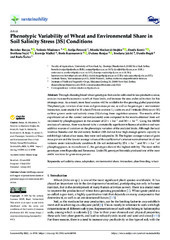Prikaz osnovnih podataka o dokumentu
Phenotypic variability of wheat and environmental share in soil salinity stress [3S] conditions
| dc.creator | Banjac, Borislav | |
| dc.creator | Mladenov, Velimir | |
| dc.creator | Petrović, Sofija | |
| dc.creator | Matković-Stojšin, Mirela | |
| dc.creator | Krstić, Đorđe | |
| dc.creator | Vujić, Svetlana | |
| dc.creator | Mačkić, Ksenija | |
| dc.creator | Kuzmanović, Boris | |
| dc.creator | Banjac, Dušana | |
| dc.creator | Jakšić, Snežana | |
| dc.creator | Begić, Danilo | |
| dc.creator | Šućur, Rada | |
| dc.date.accessioned | 2022-10-20T12:04:25Z | |
| dc.date.available | 2022-10-20T12:04:25Z | |
| dc.date.issued | 2022 | |
| dc.identifier.issn | 2071-1050 | |
| dc.identifier.uri | http://fiver.ifvcns.rs/handle/123456789/3169 | |
| dc.description.abstract | Through choosing bread wheat genotypes that can be cultivated in less productive areas, one can increase the economic worth of those lands, and increase the area under cultivation for this strategic crop. As a result, more food sources will be available for the growing global population. The phenotypic variation of ear mass and grain mass per ear, as well as the genotype × environment interaction, were studied in 11 wheat (Triticum aestivum L.) cultivars and 1 triticale (Triticosecale W.) cultivar grown under soil salinity stress (3S) during three vegetation seasons. The results of the experiment set on the control variant (solonetz) were compared to the results obtained from soil reclaimed by phosphogypsum in the amount of 25 t × ha−1 and 50 t × ha−1. Using the AMMI analysis of variance, there was found to be a statistically significant influence of additive and nonadditive sources of variation on the phenotypic variation of the analyzed traits. Although the local landrace Banatka and the old variety Bankut 1205 did not have high enough genetic capacity to exhibit high values of ear mass, they were well-adapted to 3S. The highest average values of grain mass per ear and the lowest average values of the coefficient of variation were obtained in all test variants under microclimatic condition B. On soil reclaimed by 25 t × ha−1 and 50 t × ha−1 of phosphogypsum, in microclimate C, the genotypes showed the highest stability. The most stable genotypes were Rapsodija and Renesansa. Under 3S, genotype Simonida produced one of the most stable reactions for grain mass per ear. | sr |
| dc.language.iso | en | sr |
| dc.publisher | Basel : MDPI | sr |
| dc.relation | info:eu-repo/grantAgreement/MESTD/inst-2020/200117/RS// | sr |
| dc.rights | openAccess | sr |
| dc.rights.uri | https://creativecommons.org/licenses/by/4.0/ | |
| dc.source | Sustainability - Basel | sr |
| dc.subject | soil salinity | sr |
| dc.subject | soil salinity stress | sr |
| dc.subject | adaptation | sr |
| dc.subject | environmental share | sr |
| dc.subject | interaction | sr |
| dc.subject | plant breeding | sr |
| dc.subject | wheat | sr |
| dc.subject | phenotypic variability | sr |
| dc.title | Phenotypic variability of wheat and environmental share in soil salinity stress [3S] conditions | sr |
| dc.type | article | sr |
| dc.rights.license | BY | sr |
| dc.citation.issue | 14 | |
| dc.citation.rank | M22 | |
| dc.citation.spage | 8598 | |
| dc.citation.volume | 14 | |
| dc.identifier.doi | 10.3390/su14148598 | |
| dc.identifier.fulltext | http://fiver.ifvcns.rs/bitstream/id/8873/bitstream_8873.pdf | |
| dc.identifier.scopus | 2-s2.0-85136416317 | |
| dc.identifier.wos | 00083234010000 | |
| dc.type.version | publishedVersion | sr |


